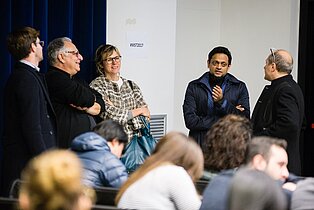Review | Shajay Bhooshan at the November Talks 2017 in Milan
Nowadays terms like robotics, 3D printing, digital design and fabrication are among the technologies, which tend to shape the future of design technology. The efforts of ZHCODE in the past ten years have focused on computational geometry as “the mediating instrument to negotiate morphological, engineering and manufacturing logics”. Surprisingly, during the lecture Shajay Bhooshan explored the constant link with the past as a valuable source of inspiration to perform new computational design concepts. Looking into the future is thus considered by Bhooshan as a rediscovery of history, with the lecture entitled “The end is to build well. Well building hath three conditions: firmness, commodity and delight”.
Bhooshan joined Zaha Hadid Architects ten years ago, where he cofounded the computation and design team of CoDe. With the intention to put into practice his knowledge in programming, geometry and mathematics, a team of architects and mathematicians grew quickly, and comprises 9 people today. Today, CoDe research is applied to all designs envisioned by ZHA, taking advantage of different digital design tools set differently every time to accommodate the project requirements.
Design research and applied science are today extremely connected and thanks to computational technologies, it is possible to take natural shapes as references and combine them into architectural designs that are described by what Bhooshan called descriptive geometry, building physics and material chemistry. “How do you retain the idea? How do you communicate your intentions? Many innovative designers used geometries and principles that CoDe is now exploring. Architects like Gaudì, Sauvestre, the Eames, Frei Otto and the builders of the Gothic cathedrals are very inspirational to Bhooshan, who stated “we want to turn historic knowledge into contemporary knowledge”. Spanning six years of applied research, Bhooshan described the transfer of method and knowledge from collaborations and prototypes to projects. Currently involved in a PhD at ETH Zurich, Bhooshan is now collaborating with the Block Research Group (BRG), which is particularly involved in the computational exploration of structural forms and appropriate methods of construction. The BRG works with CoDe, introducing force-driven computational tools and methods for the exploration of freeform curved surface structures. Nest Hilo (2017) is a result of this collaboration, a double curved thin shell roof structure that offers high degrees of control over the shape such that it can be easily optimised for improved structural behaviours compared with traditional geometries. Another great example that well described how “shape does not come by accident” is the Winton Gallery (2016), which brings together history, mathematics and design to create translucent backlit fabric pods that highlight the role of mathematical practice in our lives and explores how mathematicians, their tools and ideas have helped build the modern world over the past four centuries. Additionally, the gallery has several spots where people can rest, including fourteen benches made of ultra-high-performance concrete. The shapes, made with 3D cut technologies, benefitted from the method of descriptive geometry.
The parametric design method is underlined by a directed search that seeks a solution that is “efficacious in its design and production and harmonious for human occupation”. In this last sentence lies another important key element for Bhooshan, according to which architecture should consider its societal purpose. Following the research of Patrick Schumacher, the study of how to reproduce social circumstance in architecture has been explored by CoDe by using occupant density and spatial statistics with digital building sensor data and other tools. With ZHA, Bhooshan created several interactive installations in order to better understand what it means to deal with the social behaviour of the occupants inside a built space. Unconfined (2017) is a collaboration between the practice and Universal Everything for Samsung that centres design, technology and user experience in a unique immersive digital installation.
What was more impressive about this lecture was the ability of Shajay Bhooshan to talk about the future by embracing the past. Full of reminiscences and quotes, the keynote opened a series of questions and showed us the innovative and unique approach of parametric design.
Interview with Shajay Bhooshan
The Video can be found on our YouTube-Channel.
November Talks
The successful “November Reihen”, a lecture series on contemporary architecture, has been funded by the non-profit Sto Foundation since its launch in 2006. Stuttgart, Graz, Milan, Paris, Prague and London are the six venues . Exciting work reports by renowned architects can be experienced there.



















